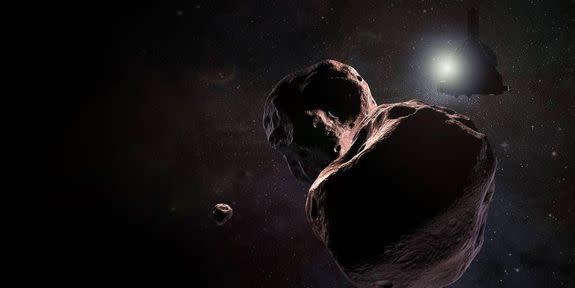Mysterious deep space world Ultima Thule already looks weird — and we've only had a glimpse

Ultima Thule — an uncharted world over 4 billion miles away — is coming into view.
On Monday, planetary scientists released a fuzzy image of Ultima Thule, snapped the day prior by the New Horizons exploration spacecraft from some 1.2 million miles away. Previously, New Horizons swooped by Pluto in 2015, capturing the icy, mountainous world in unprecedented detail.
Increasingly rich, detailed images of Ultima will start arriving on January 2, but already the deep space object looks elongated, not round, said New Horizons deputy project scientist John Spencer from the Johns Hopkins University Applied Physics Laboratory, the Maryland headquarters of the New Horizons program. The program is a collaborative effort between NASA, the Southwest Research Institute (SwRI), and the Johns Hopkins Applied Physics Laboratory, where scientists navigate and control the spacecraft.
"It’s the first glimpse of what's going to get rapidly better from here on — it’s our first taste," Spencer said.

Image: JHuAPL/Nasa
Whether Ultima's surface is heavily cratered and if it has a rich surface geology — like that of Pluto — remains to be seen.
"Anything is possible out there in this very unknown region," he said.
Ultima lies 1 billion miles beyond Pluto, in a ring of icy worlds known as the Kuiper Belt. Planetary scientists believe the objects out there have been frozen in time for some 4 billion years — preserving what happened during our solar system's early formation, long ago.
SEE ALSO: How NASA recorded the eerie Martian wind, without a microphone
"The Kuiper Belt is just a scientific wonderland,” Alan Stern, principal investigator of the New Horizons mission, said on Sunday.
“We've never, in the history of spaceflight, gone to a target that we know less about," Stern added.
Already, Ultima has proven mysterious. As New Horizons travels closer to the object, the pattern of light reflecting off of Ultima, or its light curve, is inconsistent. With most other objects, these light patterns repeat as the objects spin.

Image: nasa
"It's really a puzzle," said Stern in a statement last week.
But much of Ultima's mystery will diminish in the next few days. Just 33 minutes into the new year local time, New Horizon's will swoop some 2,200 miles above Ultima, capturing detailed snapshots of the uncharted world. But because Ultima is so far away, these rich images won't be immediately available. The data will be transmitted back to Earth, and on January 2 the first detailed snapshots will emerge of this elongated, though still largely mysterious, object.
Ultima will soon become the most distant world humanity has ever visited.
WATCH: Ever wonder how the universe might end?


